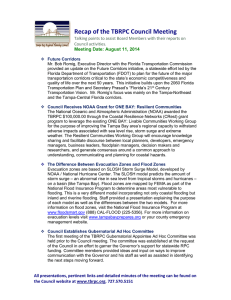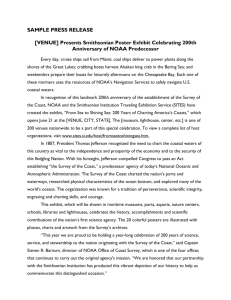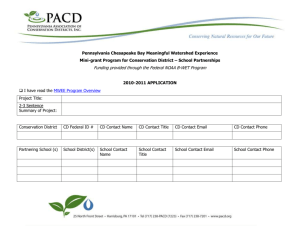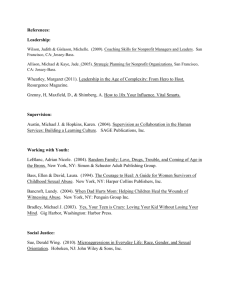Ref_note
advertisement
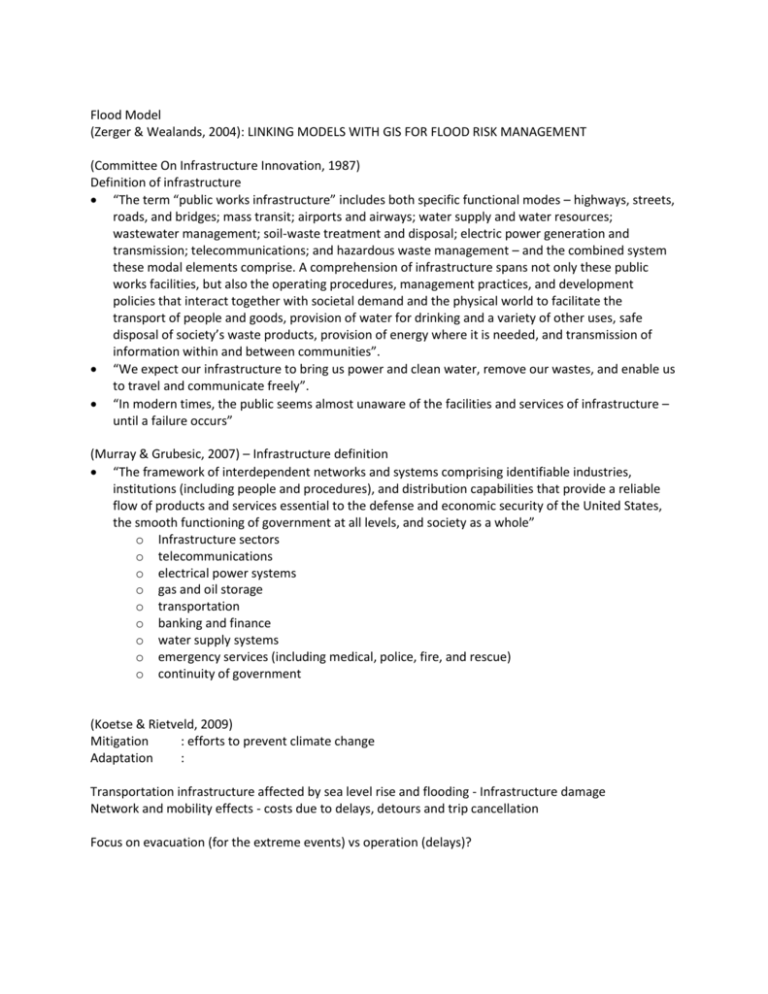
Flood Model (Zerger & Wealands, 2004): LINKING MODELS WITH GIS FOR FLOOD RISK MANAGEMENT (Committee On Infrastructure Innovation, 1987) Definition of infrastructure “The term “public works infrastructure” includes both specific functional modes – highways, streets, roads, and bridges; mass transit; airports and airways; water supply and water resources; wastewater management; soil-waste treatment and disposal; electric power generation and transmission; telecommunications; and hazardous waste management – and the combined system these modal elements comprise. A comprehension of infrastructure spans not only these public works facilities, but also the operating procedures, management practices, and development policies that interact together with societal demand and the physical world to facilitate the transport of people and goods, provision of water for drinking and a variety of other uses, safe disposal of society’s waste products, provision of energy where it is needed, and transmission of information within and between communities”. “We expect our infrastructure to bring us power and clean water, remove our wastes, and enable us to travel and communicate freely”. “In modern times, the public seems almost unaware of the facilities and services of infrastructure – until a failure occurs” (Murray & Grubesic, 2007) – Infrastructure definition “The framework of interdependent networks and systems comprising identifiable industries, institutions (including people and procedures), and distribution capabilities that provide a reliable flow of products and services essential to the defense and economic security of the United States, the smooth functioning of government at all levels, and society as a whole” o Infrastructure sectors o telecommunications o electrical power systems o gas and oil storage o transportation o banking and finance o water supply systems o emergency services (including medical, police, fire, and rescue) o continuity of government (Koetse & Rietveld, 2009) Mitigation : efforts to prevent climate change Adaptation : Transportation infrastructure affected by sea level rise and flooding - Infrastructure damage Network and mobility effects - costs due to delays, detours and trip cancellation Focus on evacuation (for the extreme events) vs operation (delays)? (Herrera & Gleick, 2009) THE IMPACTS OF SEA-LEVEL RISE ON THE CALIFORNIA COAST Data sources Coastal flood and erosion hazards: Philip Williams and Associates Transportation data: MTC, Caltrans LiDAR: NOAA, DEMs (NOAA’s Coastal Service Center) Other GIS: CRA, FEMA “Critical infrastructure, such as roads, hospitals, schools, emergency facilities, wastewater treatment plants, power plants, and more” “Major transportation corridors and other critical infrastructure are found along the California coast, including oil, natural gas, and nuclear energy facilities, as well as major ports, harbors, and water and wastewater plants.” “The study area spans approximately 1,100 miles of California’s Pacific coast and 1,000 miles of shoreline along the perimeter of the San Francisco Bay. The San Francisco Bay study area extends from the Golden Gate in the west to Pittsburg, California, in the east and San Jose in the south. The eastern boundary of the San Francisco Bay study was set according to where United States Geological Survey (USGS) researchers were able to extract reliable flood elevations from the Bay hydrodynamic model. We provide estimates for a number of scenarios for San Francisco Bay due to the ready availability of high‐resolution geographic data provided by the USGS.” “Higher sea levels, however, can also worsen flooding in nearby rivers as higher water surface elevations at the downstream end of a river causes water to back up and increase upstream flooding. These impacts are not evaluated here.”- limitations !! Elevation datasets used for mapping coastal flood risks Extensive data sources at NOAA (http://www.csc.noaa.gov/digitalcoast/data/index.html) Expected risk to the coast (chapter 2.3) Resources threatened by sea-level rise o Population (number / ej) o “According to the IPCC, “Vulnerability to climate change is the degree to which these systems are susceptible to, and unable to cope with, adverse impacts” (Schneider et al. 2007). Vulnerability is a function of the magnitude of the impact, the sensitivity of the system to that impact, and the system’s ability to adapt. Vulnerabilities, like lack of access to a vehicle or other means of transportation, are shaped by “intervening conditions” that are not tied to a specific hazard but will greatly determine the human impact of the disaster and the specific needs for preparedness, response, and recovery (Hewitt 1997).” Limitations (need to summarized) Data Sources EcoAtlas - http://www.sfei.org/ecoatlas NOAA National Shoreline dataset - http://shoreline.noaa.gov/data/datasheets/

